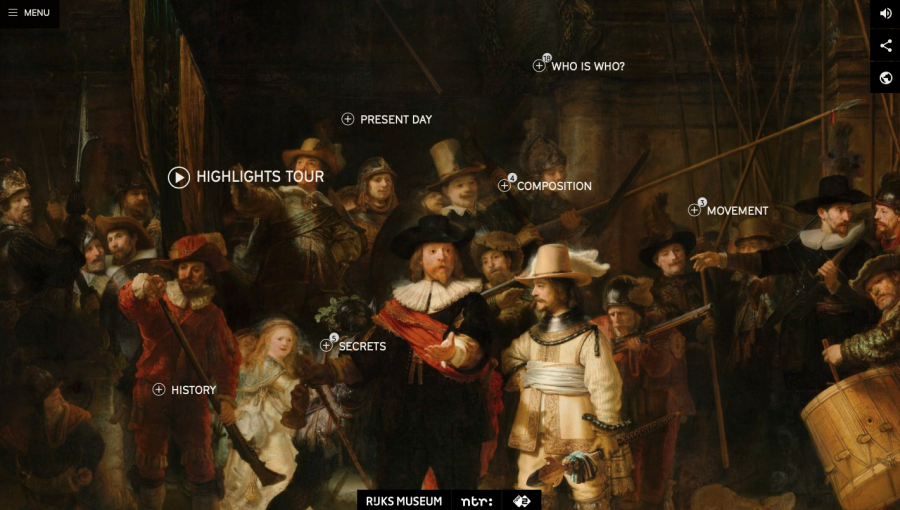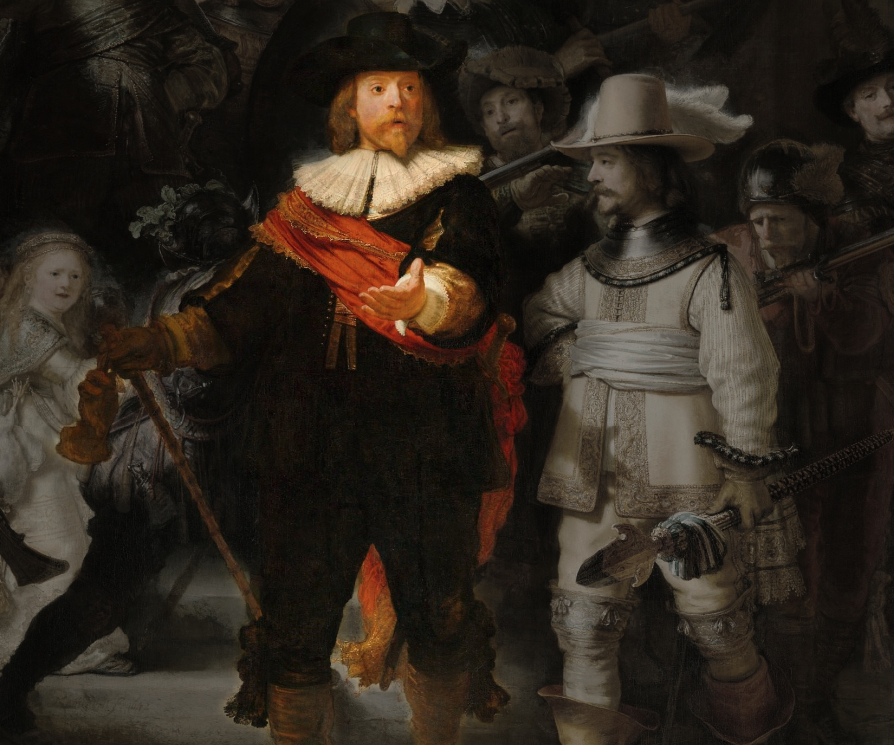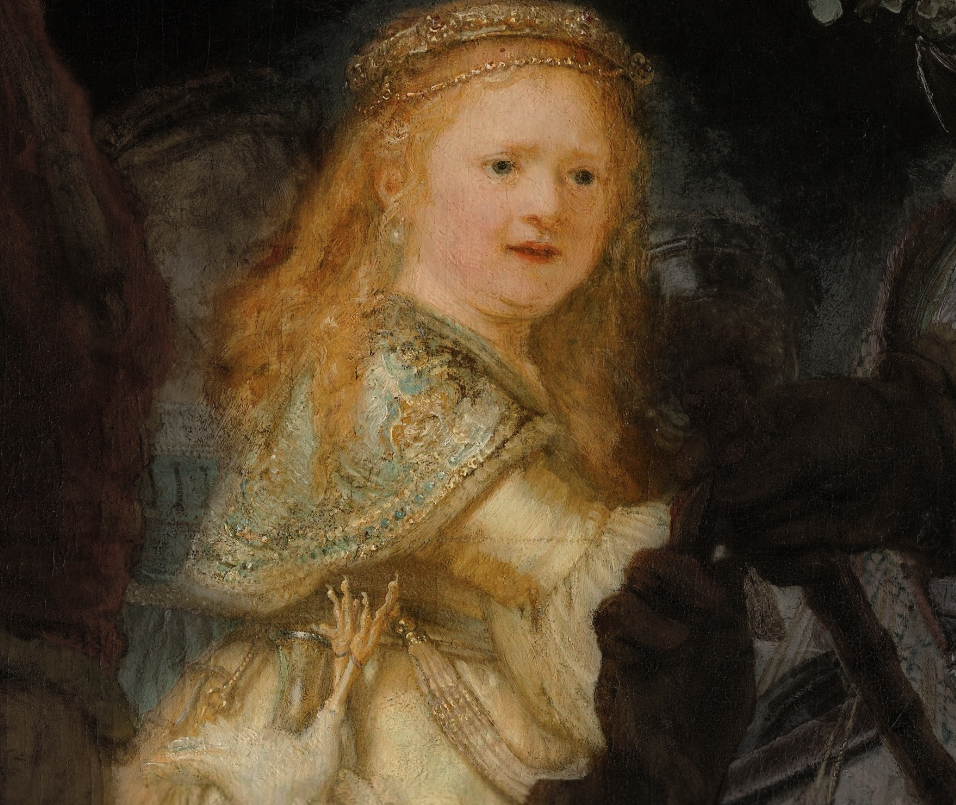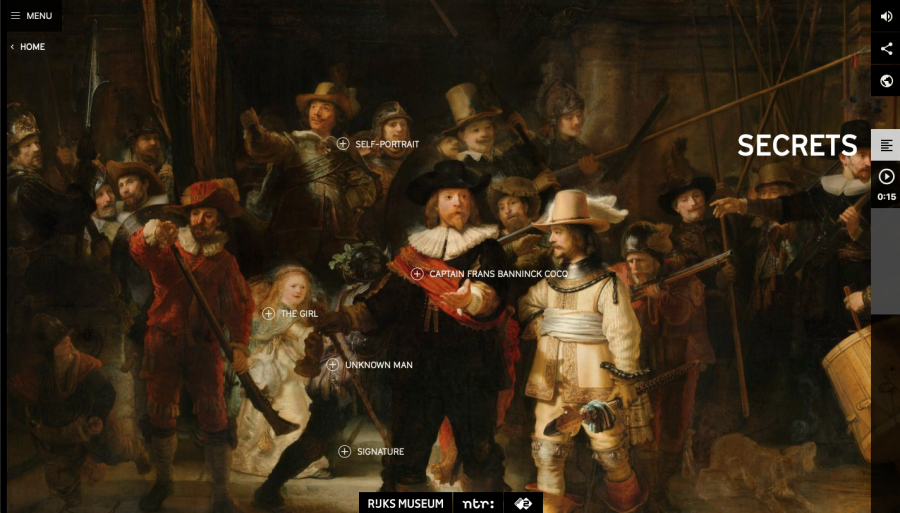[Most Recent Entries] [Calendar View]
Wednesday, January 30th, 2019
| Time | Event |
| 9:00a | Enter an Online Interactive Documentary on Rembrandt’s The Night Watch and Learn About the Painting’s Many Hidden Secrets
What possessed the man who attacked Rembrandt’s The Night Watch with a bread knife in 1975, “jabbing two-foot-long knife marks into the surface,” as Nina Siegal writes at The New York Times, “cutting a seven-foot-wide hole, and ripping off a section of the canvas”? This was not the first time the painting had been mangled. In 1715, just a little over 70 years after the monumental work’s 1642 completion, the Amsterdam city government decided to move it, and removed a significant part to shrink it down for easier transport. The missing top and left portions have never been recovered. It survived intact for two centuries then faced its first knife attack in 1911. Then it survived two World Wars only to endure the second attack. Then, in 1990, it was set upon by a man armed with sulphuric acid. Thanks to the quick thinking of a Rijksmuseum guard, only the painting’s varnish sustained injury. These are just some of the facts we learn in the interactive documentary Experience The Night Watch, a joint creation of NTR TV channel and the Amsterdam Rijksmuseum.
You can read or hear the painting’s history in Dutch or English, learn the names of the historical figures depicted in it, learn about Rembrandt’s command of composition and chiaroscuro, and much more. (Enter the interactive documentary here.) The painter's masterful, dramatic use of light and shadow to create a sense of depth—probably the most famous example of his use of the technique—is responsible for the painting’s usual title, since most of its viewers have assumed that the assembled volunteer militia depicted in it came together in the dead of night. (The shadows had darkened considerably over the years until a thick layer of varnish was removed in the 1940s.)
But Rembrandt’s masterpiece was originally called Militia Company of District II under the Command of Captain Frans Banninck Cocq, and it records not a troop of seasoned soldiers but a gentleman’s shooting company, one of the bands of civic guards that had “effectively developed into a social club for well-to-do citizens” who would “turn up mostly as ceremonies or to quell minor riots.” Each of the men memorialized paid to have his likeness included. We may never have known their names except that in 1715 they were added inside a shield painted by an anonymous artist for some reason. The work is full of other such mysteries.
Who is the small girl in white, bathed in angelic light, to whom our eyes are inevitably drawn? “She does not have any traceable identity,” our narrator tells us, “she is Rembrandt’s invention,” a symbol of the company. And yet behind her, almost completely shrouded, is another girl, identity unknown, who most of us would probably never have noticed had she not been pointed out. “In The Night Watch,” we discover, “nothing is what it seems.” Learn more of the painting’s secrets at the online documentary project here, see similarly interactive art histories from NTR on M.C. Escher and Hieronymus Bosch, and, above, listen to an Artsy podcast featuring Rijksmuseum curator Pieter Roelofs and other Rembrandt experts who explain what makes The Night Watch so wildly famous that more than one person has felt driven to destroy it.
Related Content: 300+ Etchings by Rembrandt Now Free Online, Thanks to the Morgan Library & Museum Rijksmuseum Digitizes & Makes Free Online 361,000 Works of Art, Masterpieces by Rembrandt Included! What Makes The Night Watch Rembrandt’s Masterpiece Enter an Online Interactive Documentary on M.C. Escher’s Art & Life, Narrated By Peter Greenaway Take a Virtual Tour of Hieronymus Bosch’s Bewildering Masterpiece The Garden of Earthly Delights Enter an Online Interactive Documentary on Rembrandt’s The Night Watch and Learn About the Painting’s Many Hidden Secrets is a post from: Open Culture. Follow us on Facebook, Twitter, and Google Plus, or get our Daily Email. And don't miss our big collections of Free Online Courses, Free Online Movies, Free eBooks, Free Audio Books, Free Foreign Language Lessons, and MOOCs. |
| 12:00p | Artificial Intelligence Brings Salvador Dalí Back to Life: “Greetings, I Am Back” Whatever Hippocrates meant when he said “art is long, life is short,” we usually take the saying to illustrate one indisputable medical truth and one more philosophical: everyone dies, but art lives for hundreds, thousands, of years—and may in some sense be a kind of immortality for the artist. This was probably what Salvador Dalí meant when he said, “Si muero, no muero por todo”—“If I die, I won’t completely die.” But maybe he knew he’d return one day in another form as well. What if artists could go on living forever alongside their work? Or be called up any time we want to have a conversation. Long a staple of science fiction, hologram technology can now bring back famous pop stars, to varying degrees of uncanniness. It has not, until now, summoned a deceased famous artist. But as long as there’s an extensive audio-visual record with which to reconstruct the celebrated dead, it can be done, and now it has. You can see the results yourself in the video trailers here. Among modern artists, only Andy Warhol left a more complete record of his public persona. The hologram Dalí—according to a press release from Dalí Museum in St. Petersburg, Florida, who will debut him in person, so to speak, this coming April—comes alive through the work of an algorithm that maps information culled from "hundreds of interviews, quotes, and existing archival footage" onto the body of an actor of similar size and build. Dalí's conversation is not spontaneous but constructed from his own writings and reenacted. It's not the stuff of Star Trek yet, but maybe a significant step in that direction. “Greetings,” purrs Dalí in the trailer at the top, from the Dalí Museum in St. Petersburg, Florida. “I am Salvador Domingo Felipe Jacinto Dalí i Domènech. And I am back.” Visitors to the Dalí Museum will see the ersatz Dalí in “Dalí Lives" and "experience his bigger-than-life personality in an up close and personal way.” Will they truly “get the unique opportunity to learn more about Salvador Dalí’s life and work from the person who knew him best: Dalí himself”? Will they feel like it’s worth the price of the ticket, at least? It certainly seems convincing. If you had told me these clips came from actual interview footage, I might have believed you. Except for the part about him returning from the dead after 30 years. If, however, it were possible to really bring Dalí’s consciousness back online, I doubt he’d be particularly surprised. Though he confesses his fear of death in the short video above, he also tells us, “I do not believe in my death.” Or as he once said elsewhere, “I believe in general death but not the death of Dalí absolutely not. I believe in my death becoming almost impossible.” Or as he might also have put it, “art is long, and so am I.” via Boing Boing Related Content: Walk Inside a Surrealist Salvador Dalí Painting with This 360º Virtual Reality Video Salvador Dalí Figurines Let You Bring the Artist’s Surreal Paintings Into Your Home Josh Jones is a writer and musician based in Durham, NC. Follow him at @jdmagness Artificial Intelligence Brings Salvador Dalí Back to Life: “Greetings, I Am Back” is a post from: Open Culture. Follow us on Facebook, Twitter, and Google Plus, or get our Daily Email. And don't miss our big collections of Free Online Courses, Free Online Movies, Free eBooks, Free Audio Books, Free Foreign Language Lessons, and MOOCs. |
| 3:00p | Neil Gaiman Teaches the Art of Storytelling in His New Online Course How has Neil Gaiman, author of fiction in a variety of forms ranging from novels and short stories to comic books, radio plays, and films, managed to win over such a large and devoted fan base? Ask a member of that fan base, and you'll more than likely hear an explanation along the lines of, "He knows how to tell a story." That may sound like a simple skill, but telling a story at Gaiman's level requires a deep-rooted expertise in the essential nature and still-unexplored possibilities of storytelling itself — an expertise that Gaiman himself has lately proven more than willing to share. A few years ago we featured his lecture "How Stories Last" here on Open Culture; now, he's come out with an online course on the art of storytelling at MasterClass. "Human beings are storytelling creatures," Gaiman says in the course's trailer above. "Stories are vital. We convey truth with stories. That is the magic of fiction." But even the author of stories like The Sandman, Neverwhere, Stardust, American Gods, Coraline, and much more besides has certain admissions to make about the practice of writing them: "Writing a novel is like driving through the fog with one headlight out," for example. "You can't see very far ahead of yourself. But every now and again, the mists will clear." And when it comes time to revise, he explains, "the process of doing your second draft is the process of making it look like you knew what you were doing all along." What do you need most to make it through this harrowing process? The "conviction that you are brilliant." Not that you don't need anything else. The nineteen lessons of Gaiman's MasterClass cover everything from "using the 'lie' of a made-up story to tell a human truth," to "how to overcome the fear of making mistakes," to techniques like "cold opens, withholding information, finding emotional weight, and choosing memorable details," to the art of worldbuilding, which Gaiman describes as "honestly, the joy of getting to play god." Other lessons provide case studies focusing on his short stories, novels, and comic books, all of which have no doubt inspired many to tell stories themselves. But who, hearing Gaiman talk about storytelling, could possibly resist trying their hand at it? You can take his course for $90. Or if you if pay $180, you can access his course, plus every other course in the MasterClass catalogue, for a year. FYI: If you sign up for a MasterClass course by clicking on the affiliate links in this post, Open Culture will receive a small fee that helps support our operation. Related Content: 18 Stories & Novels by Neil Gaiman Online: Free Texts & Readings by Neil Himself Neil Gaiman Reads “The Man Who Forgot Ray Bradbury” Where Do Great Ideas Come From? Neil Gaiman Explains Margaret Atwood Offers a New Online Class on Creative Writing Based in Seoul, Colin Marshall writes and broadcasts on cities, language, and culture. His projects include the book The Stateless City: a Walk through 21st-Century Los Angeles and the video series The City in Cinema. Follow him on Twitter at @colinmarshall or on Facebook. Neil Gaiman Teaches the Art of Storytelling in His New Online Course is a post from: Open Culture. Follow us on Facebook, Twitter, and Google Plus, or get our Daily Email. And don't miss our big collections of Free Online Courses, Free Online Movies, Free eBooks, Free Audio Books, Free Foreign Language Lessons, and MOOCs. |
| 6:00p | Watch Black Panther For Free in Theaters, Starting This Friday
FYI. Earlier this week, Disney announced that the Academy Award-nominated film Black Panther "will return to the big screen to celebrate Black History Month for a one-week engagement, February 1–7, at 250 participating AMC Theatres locations. To ensure that the movie is accessible to all, tickets are free for everyone, and there will be two showings per day at each participating theater." To find a list of participating theaters, just click here. Follow Open Culture on Facebook and Twitter and share intelligent media with your friends. Or better yet, sign up for our daily email and get a daily dose of Open Culture in your inbox. If you'd like to support Open Culture and our mission, please consider making a donation to our site. It's hard to rely 100% on ads, and your contributions will help us provide the best free cultural and educational materials. Related Content: Every Spider-Man Movie and TV Show Explained By Kevin Smith Watch Black Panther For Free in Theaters, Starting This Friday is a post from: Open Culture. Follow us on Facebook, Twitter, and Google Plus, or get our Daily Email. And don't miss our big collections of Free Online Courses, Free Online Movies, Free eBooks, Free Audio Books, Free Foreign Language Lessons, and MOOCs. |
| 9:26p | Watch The Beatles Perform Their Famous Rooftop Concert: It Happened 50 Years Ago Today (January 30, 1969) On January 3oth 1969, The Beatles took to the rooftop of the headquarters of Apple Records, located at 3 Savile Row, in central London. And there they played an impromptu last gig (a coda to their final official concert at Candlestick Park on August 29, 1966), much to the delight of Londoners on nearby rooftops ... and to the chagrin of the police. At the time, The Beatles were recording their album, Let It Be, and the rooftop show let them run through various tracks from those sessions. Songs played during the set include "Get Back," where the Beatles were accompanied by Billy Preston on the keyboards, and “Don't Let Me Down" (above), "I've Got A Feeling," "One After 909," and "Danny Boy." And finally "Dig A Pony" and another version of "Get Back." Famously, The Beatles' live legacy ends with the police shutting down the show (it was a noise violation, you know?) and John Lennon uttering the immortal words, "I'd like to say thank you on behalf of the group and ourselves, and I hope we passed the audition." That's going out in style... Footnote: It's not clear which band played the first rooftop concert, but one thing is for certain. Jefferson Airplane played their own rooftop gig on December 7, 1968, and Jean-Luc Godard filmed it. Once again, the police pay a friendly visit. Watch it here. Learn more about the Beatles' historic performance by picking up a copy of the recently-released book, The Roof: The Beatles' Final Concert, or download it from Audible through this free trial offer. Follow Open Culture on Facebook and Twitter and share intelligent media with your friends. Or better yet, sign up for our daily email and get a daily dose of Open Culture in your inbox. If you'd like to support Open Culture and our mission, please consider making a donation to our site. It's hard to rely 100% on ads, and your contributions will help us provide the best free cultural and educational materials. Related Content: Audio: The Beatles Play Their Final Concert at Candlestick Park, 1966 Watch The Beatles Perform Their Famous Rooftop Concert: It Happened 50 Years Ago Today (January 30, 1969) is a post from: Open Culture. Follow us on Facebook, Twitter, and Google Plus, or get our Daily Email. And don't miss our big collections of Free Online Courses, Free Online Movies, Free eBooks, Free Audio Books, Free Foreign Language Lessons, and MOOCs. |
| << Previous Day |
2019/01/30 [Calendar] |
Next Day >> |








